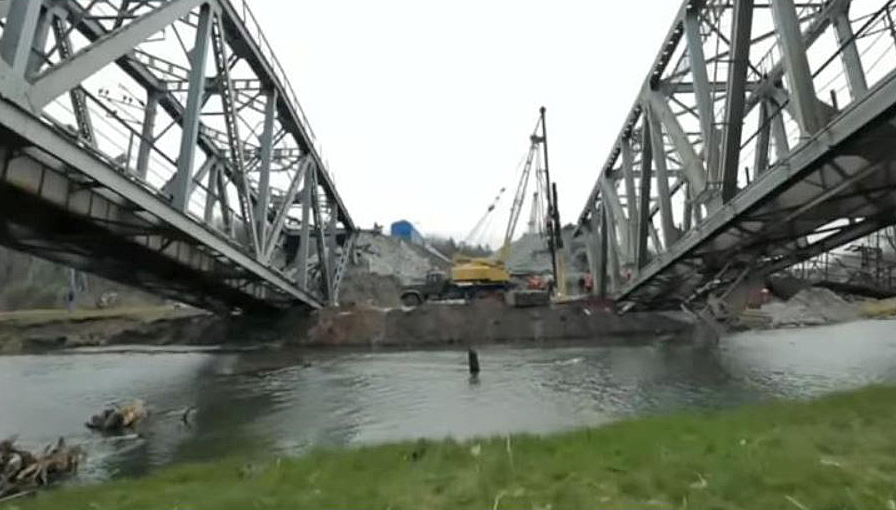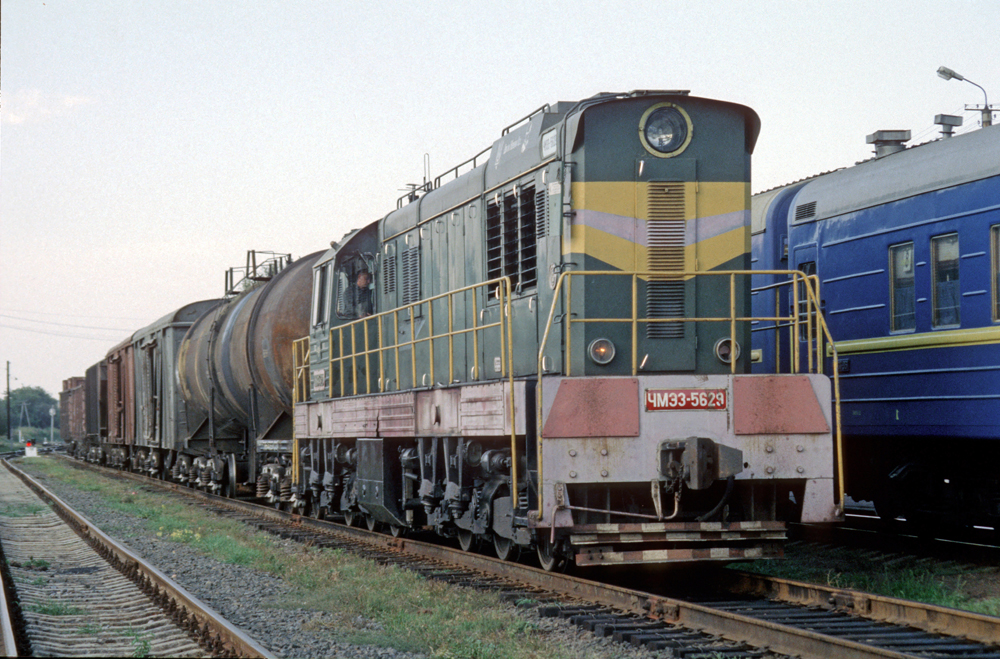
CHICAGO — Ukrainian refugee trains being operated by RDC Deutschland, the German subsidiary of Pittsburgh-based Railroad Development Corp., have stopped running as of April 19. In a presentation that day to Northwestern University’s Sandhouse Rail Group, RDC Chairmain Henry Posner III recounted experiences in operating those trains, as well as observations based on past visits to Ukraine and experiences in Estonia, like Ukraine an independent nation that was formerly part of the Soviet Union.
‘If you can’t give them ammunition, give them a ride’
Posner drew the title of his presentation, “If you can’t give them ammunition, give them a ride,” from the phrase “I need ammunition, not a ride” attributed to Ukrainian President Volodymyr Zelensky. That was reportedly Zelensky’s response to the U.S. government after Russia’s invasion of his country on Feb. 24.
Posner says the war in Ukraine is the first this century, and probably the first since World War II, where railways are fundamental both for the attacker and the defender. He highlighted that historically in Soviet days, the rail system was a key part of national defence policy. This led the railways to use a highly standardized approach which remains largely in place. There were very few locomotive types, but these were built in huge numbers; the same applied to freight cars, all built for heavy loading compared to western Europe.
Infrastructure was often deliberately duplicated so that if one route was damaged, another nearby could act as an alternative; in many cases bridges were deliberately built as single track but parallel to minimize the risk of damage to both in an attack, with spare bridge components often pre-positioned nearby. (This also used to be the case in parts of western Germany for the same Cold War reasons.) The 5-foot track gauge and signalling systems were the same all over the former Soviet Union, making repair easy.
RDC’s refugee trains
The refugee trains from the Polish border to the central German city of Hannover started on March 10 [see “As numbers grow to millions, RDC and others run trains …,” Trains News Wire, March 14, 2022].
The German government wanted to offer people arriving from Ukraine a more direct route into the country, as regular trains were all routed via Berlin where authorities were struggling to cope with the influx. The trains have stopped running as refugee numbers arriving in Poland and Germany have dwindled since Russia pulled back its forces from the Ukrainian capital Kyiv and surrounding areas. Large numbers continue to flee renewed fighting in the east of Ukraine, many of them by trains which are increasingly at risk of attack, but for now at least, most of those are remaining in the west of the country rather than continuing across the border.
Posner said that RDC Deutschland has a charter train business that runs some seasonal regular trains, but on four days’ notice was able to respond to a government request to run daily trains from Frankfurt an der Oder, on the border with Poland, halfway across the country to Hannover.
Posner was in Europe when the operation began and rode the first train as one of two interpreters, as he speaks Russian, which most Ukrainians also speak or understand. Following a suggestion by RDC, the Berlin-based Abraham Geiger College offered Ukrainian-born rabbinical students to act as translators within two days of the start of the rail service, meaning the many people onboard who spoke neither German or English had someone who could help them.
Ukraine’s railways now and in the future
Posner praised the workers of the Ukrainian rail system run by Ukrzaliznytsia (UZ). They are seen by their own people as courageous, he said, standing side by side with the armed forces in resisting the invasion and operating trains to rescue people or provide supplies, despite ongoing and increasing attacks on the rail system. He also pointed out UZ was superb at communication, so the work it is doing has received widespread attention around the world.

UZ’s ability to respond so well in part reflects the Soviet legacy, Posner suggested; having been designed to serve the national defense in wartime, it is doing just that. The redundancy of routes, and resilience of standardized equipment and pre-positioned bridge components, means damage can be fixed quickly or traffic can be rerouted.
Looking at his experience with post-Soviet railroads in Estonia, plus widely published figures on corruption — where pre-war neither Ukraine or Russia scored well — he warned that the post-war future may be more difficult. Posner found in Estonia, where RDC used to be part owner of the privatized rail freight company, that the combination of well-meaning financial support plus new regulatory situations — in Estonia’s case joining the European Union in 2004 — can present opportunities for people to enrich themselves . Sometimes, this can take the form of changing the rules so competition disappears. RDC and its partners eventually sold their interest in Estonia in 2007.
He also shared RDC’s experience in a “post-conflict’ country” — in this case the African nation of Mozambique, where the major international organizations such as USAID dominated the post-war economy and did not like the idea of private companies running rail services. His experience was that because large amounts of equipment was gifted, it was never respected. Many of the new locomotives given to Mozambique quickly ended up wrecked and were not repaired.
Posner suggests that aid for Ukraine post-war should come with conditions to prevent corruption, depriving the country of the benefit of reconstruction help. In contrast to China’s “Belt and Road” program, Posner advocates what he calls a “Belt and Suspenders” approach by the U.S. and its partners, so unintended negative consequences of financial aid are avoided.
Heroes of the conflict
Posner concluded by suggesting that as the history of the war is written, the Ukrainian railway workers will compare with the role of the French Resistance in WWII — and that Ukraine’s railway workers are among the heroes of the conflict.
The presentation was the latest in a series of programs from the Northwestern University Transportation Center’s Sandhouse Rail Group, which began in 2002 as an effort to connect active and veteran rail practitioners with students and academics interested in rail-related issues. More information is available at the Soundhouse Group website; the Posner presentation will eventually be archived there.














A little clarity is needed:
“That was reportedly Zelensky’s response to the U.S. government after Russia’s invasion of his country on Feb. 24.”
His words have no meaning in this context. Upon Russia’s invasion the Biden Administration believed that Kyiv/Kiev would fall within 72 hours. It believed the ~20 years of training that the US military has had with the Ukrainian military would have no effect. It has, and the Ukrainians are using the lessons of that training to stymie the Russian effort.
So, the US offered very cynically to fly Zelenskiy into exile and out of Ukraine. It was then that the Ukrainian president made his famous reply to the Biden administration, “I need ammunition, not a ride.”
There is information about gauge change on this wikipedia page. https://en.wikipedia.org/wiki/Bogie_exchange
How is it that Posner speaks Russian? Was he CIA? Is that why he knows ex-USSR so well?
We still haven’t read much on the gauge change. I understand how passengers change at the border, but don’t understand how cargo changes. This is a question not addressed in the numerous books I’ve read about World War II on the eastern front.
Have the Baltic states re-gauged to western European gauge?
Finally, it must be noted that US and Canadian passenger railroads couldn’t have done what Ukraine, Poland, Czechia, Slovakia and Germany have accomplished in moving refugees.
His bio says:
“He writes haiku and speaks English, Spanish, French and Russian.”
I was pretty amazed about hearing the news reports on active train service almost at the front in Mariupol. Reading up on WW2 history, the rail networks were usually the first to get destroyed, but in this case the UZ maintained service practically to the Russian checkpoints. Great stuff.
Posner is a unique person. How many CEO’s would ride a train into contested territory to confirm its operation? Who thought of hiring all of those people to provide translation?
But his points on the post conflict reconstruction are spot on. Corruption is rife where lots of money is involved, before we open the piggy banks we should provide the needed checks and balances.